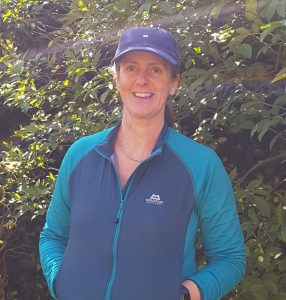We are fortunate to have some beautiful upland areas on the island of Ireland, they are generally referred to as over 300m above sea level (sub-montane), and land over 600m is described as Montane. Due to altitude and diverse weather conditions, unique communities of flora and fauna are found in upland areas.
Uplands have a colder, wetter climate, a greater extent of bog and wet heath, a greater abundance of mosses, liverworts and ferns, so from an ecological perspective we refer to ‘climate’ rather than ‘altitude’ when we refer to these areas.
Most of our upland areas have mainly ancient hard rocks, like granite, and agricultural poor soils. A mosaic of different habitats has developed including; dry and wet heath, montane heath, upland acid grassland, cliff and scree, blanket bog, scrub and woodland.
Where are the uplands on the island of Ireland?
In the west of the island there are upland areas in west Connemara, the Burren, Nephin Beg, Croagh Patrick and the Mweelrea mountains.
Throughout the rest of the island, we have the Wicklow Mountains to the east and the Galtees to the south, and the South-West uplands which include Carrauntoohil, the Macgillycuddy Reeks and the Slieve Mish mountains. North and north-west we have the Ox Mountains, the Mournes, the Sperrins and the Antrim Hills.
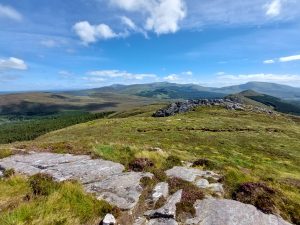
Upland plants
Our uplands have habitat such as grasslands, wet heath, and blanket bog and in dryer areas dry heath. Native flowering plants such as Bilberry, Heathers (Ling, Cross-leaved Heath and Bell Heather), Round-leaved Sundew, Bog Asphodel, Lousewort, Tormentil, Crowberry, Cranberry, Heath Milkwort, Heath Spotted Orchid, Heath Bedstraw, Western Gorse, Dwarf and Creeping Willow have adapted to the exposed, nutrient-poor conditions of the uplands.
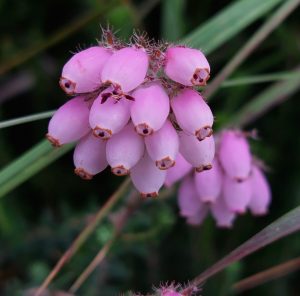 |
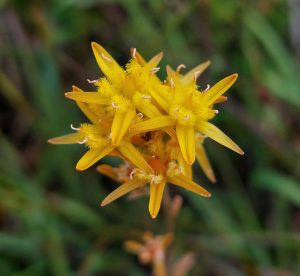 |
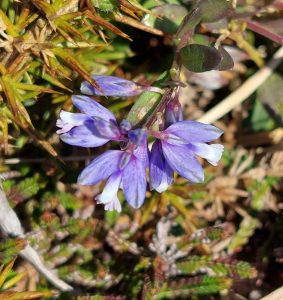 |
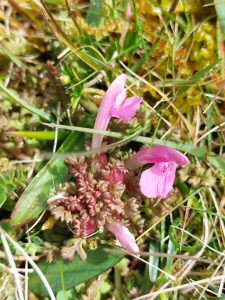 |
Pollinators in the uplands
Some wildlife can be easy to see or hear in the uplands, such as the Skylark, hovering overhead with its beautiful long-winded song, to mark its territory. It can be a little more challenging to see pollinators, especially on a sunny day with a good breeze, when bumblebees zoom past at great speed.
To observe pollinators, you need to slow down and find a sheltered sunny location, where upland plants are in flower such as Bilberry (April to July) or Heathers (Cross-leaved heath – May to September, Bell heather – July to September, Ling – July to October), then just keep your eyes peeled and your ears pinned.
Upland bumblebee species are heavily dependent on Heathers and related species, including Bilberry (also known as Fraochán or Blaeberry). An abundance of these upland flowers close to species-rich grasslands and native woodland areas is ideal for these species.
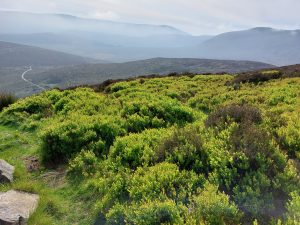 |
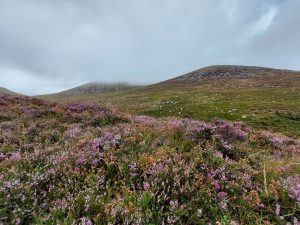 |
Bumblebees
Bumblebees are large and furry as an adaptation to colder climates and are scarce in warmer regions where they tend to overheat in hot weather. Bumblebees and other pollinators are particularly attracted by the nectar that is produced by the flower-rich Heather plant.
We have 21 bumblebee species in Ireland, here are 2 bumblebee species to look out for in upland areas:
Mountain Bumblebee Bombus monticola.
- A beautiful coloured small bee with a red-orange tail extending to nearly 50% of the abdomen.
- First recorded in Ireland in 1974 and has increased its range, although not recorded in the west of Ireland, so far.
- A flight period from March to September, they will visit Bilberry, Gorse, White clover, Heathers, Wild Thyme and Devil’s-bit scabious.
- Often found in the company of the Heath Bumblebee.
- May resemble the Early Bumblebee (Bombus pratorum) and the Red-tailed Bumblebee (Bombus lapidarius)
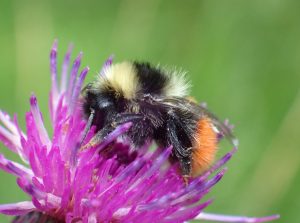
Heath Bumblebee Bombus jonellus.
- A short-tongued bee, making it suitable for feeding from Heathers, Thistles, Ragworts, Knapweed and Bird’s-foot trefoil.
- Queens emerge from February to March and feed on Willow catkins and the workers on Heathers and dwarf shrub species, such as Bilberry.
- May resemble the Garden Bumblebee (Bombus hortorum).
- They are mainly found in bog and heath areas but can also be found in a wide range of habitats.
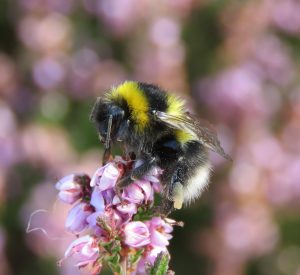
Solitary bees
We have 80 different solitary bee species; some are specialised to feed on Heather and Bilberry and time their flight period to flowering of these upland plants. Here are four solitary bee species to look out for in upland areas:
Bilberry Mining Bee Andrena lapponica
- A lovely early species to spot in heathy areas, can be seen from late April to early July, peaking in May.
- The females forage almost exclusively on Bilberry, which flowers from April to June.
- The females are similar in appearance to several other species, but they have a black face, legs and abdomen.
- They will also feed on Cowberry, Hawthorn/Whitethorn, Willows, Speedwells and occasionally Violets.
- They’re a ground nesting bee, usually in sandy or dry peaty soil.
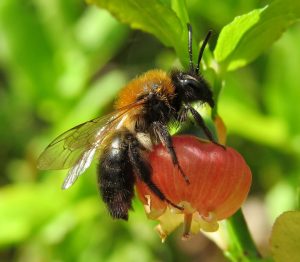 |
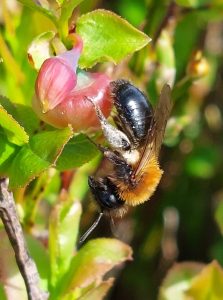 |
Heather Colletes Bee Colletes succinctus
- Strongly associated with bog, heath and heathy woodland.
- A dry heathland specialist, both upland and lowland.
- They forage on Heathers (both Erica and Calluna).
- A later flight period is June to September, to time the heather flowering period.
- Ground nesting in sandy/peaty soils.
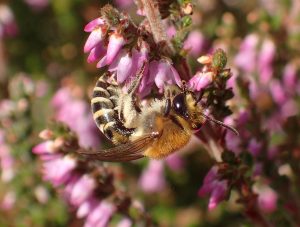
Heather Colletes Bee Colletes succinctus feeding from Ling heather. Steven Falk.
Heather Mining Bee Andrena fuscipes
- Found where there are extensive areas of Heather
- A dry heath specialist, both upland and lowland.
- They have a late summer flight period from August to September to coincide with the Heather flowering period.
- Ground nesting in dry and sandy soils.
-
A scarce and vulnerable species.

Tormentil Mining Bee Andrena tarsata
- This tiny bee is not common, and is seldom recorded, they specialise in collecting pollen from Tormentil (Potentilla), from a range of habitats, but most strongly associated with heath/bog sites.
- Their flight period is June to August, when Tormentil is in flower.
- Males will feed on nectar from Tormentil and other plants, like Bramble.
- Another ground nesting bee, usually in sandy soil and in consolidated peaty soils.
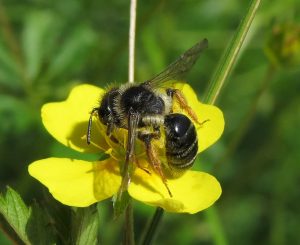
Hoverflies
We have around 180 species of hoverfly on the island of Ireland, they’re the second most important pollinator after wild bees. They can be tricky to identify by sight and it is usually necessary to check specific features for correct identification.
Heather, Tormentil and Heath Bedstraw are good flowers to check for foraging hoverfly in upland areas. Here’s an example of a hoverfly associated with upland areas:
Little Meadow Hoverfly Chrysotoxum arcuatum
- A hoverfly that is more common in upland areas.
- A wasp-mimicking hoverfly, they hover low to the ground.
- Flowers it visits include Heather, Tormentil, Creeping Willow and Bramble.
- Usually found on wet ground, fens and at the edge of woodland (both conifer and deciduous).
- They’ve a fascinating life cycle, as adults have been observed laying eggs over ant nests, where the larvae are thought to feed on root aphids associated with ant colonies.
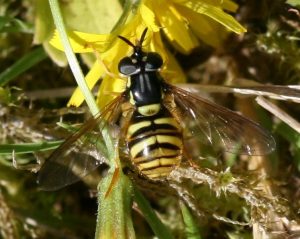
White-barred Peat Hoverfly Sericomyia lappona
- Flies low, around 3m from the ground, along tracks and streams in woodland and heath.
- Flight period is from late May to October.
- Often settles on foliage of low-growing plants or bushes and on the ground near water.
- Forages on Ling heather, Meadowsweet, Creeping Buttercup, Bramble, Creeping Willow and Rowan.
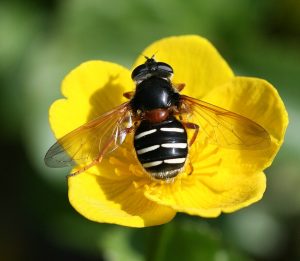
That’s just a small insight into a few of the amazing pollinators that have adapted to survive in the cool and wet uplands on the island of Ireland.
Why not see if you can spot some on your next walk in the hills.
If you’re able to take a photograph of the pollinator and would like help in identification you can visit the Irish insect group on Facebook, they can help with identification. Or you can email: [email protected]
When identification has been confirmed, you can then record your sighting to:
Recording System :: Ireland’s Citizen Science Portal (biodiversityireland.ie)
For further information on habitat
Irish Vegetation Classification – National Biodiversity Data Centre (biodiversityireland.ie)
HE.pdf (biodiversityireland.ie)
If you’d like further information on pollinators on the island of Ireland, just visit:
All-Ireland Pollinator Plan » All-Ireland Pollinator Plan (pollinators.ie)
Don’t forget to stay safe in the hills Staying Safe (mountaineering.ie) and appreciate that access is usually at the goodwill and tolerance of landowners Access in Ireland (mountaineering.ie).
